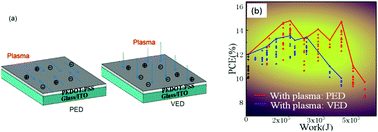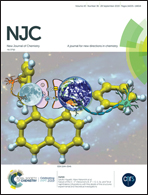Furrowed hole-transport layer using argon plasma in an inverted perovskite solar cell
Abstract
In inverted perovskite solar cells, poly(3,4-ethylene dioxythiophene) (PEDOT) and poly(styrene sulfonate) (PSS) are traditional hole transport materials. In such cells, functional improvement is becoming harder to achieve for the device. However, in this study, a novel process was found to be effective using the argon-plasma treatment, in which the ion cluster was used to scour the PEDOT:PSS surface instead of the traditional bombardment method. By an ideal plasma-generation power and treatment time (1800 J), the largest photoelectric conversion efficiency (PCE) of the device of PED (PEDOT:PSS surface being parallel to the plasma-generation electric field direction) reaches 14.8% with an improvement of 23.3% compared to the VED (vertical to the plasma electric field direction) device whose PCE is 13.31%, while the PCE of the reference is 12.0%. As per the physical mechanism, both PED and VED treatment can increase the surface free energy and roughness to result in a suitable hydrophilicity and larger grain size of the perovskite film. With the change in the ratio of PEDOT and PSS by the plasma treatment, the conductivity of the film also increases observably. Furthermore, since PED has the furrowing effect on the PEDOT:PSS surface, the ordered crystallization leads to perovskite films with few pinholes, and improves the abovementioned properties better than VED.



 Please wait while we load your content...
Please wait while we load your content...